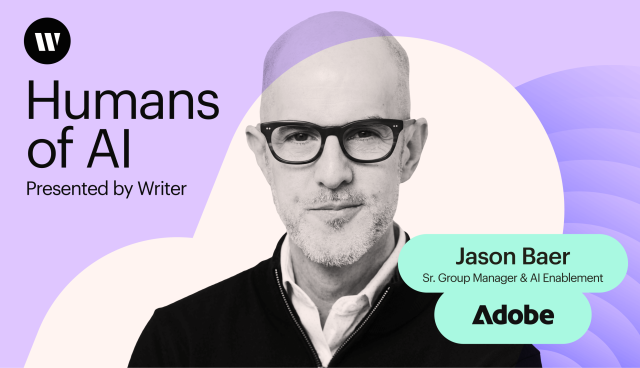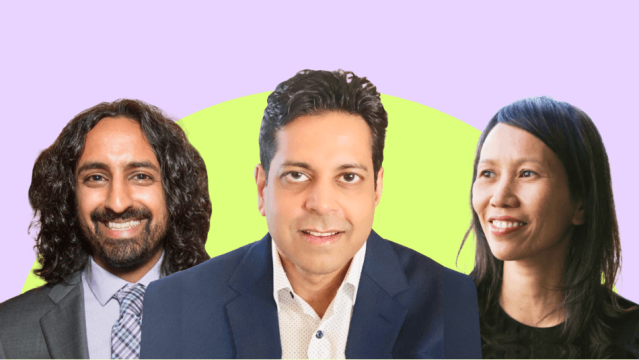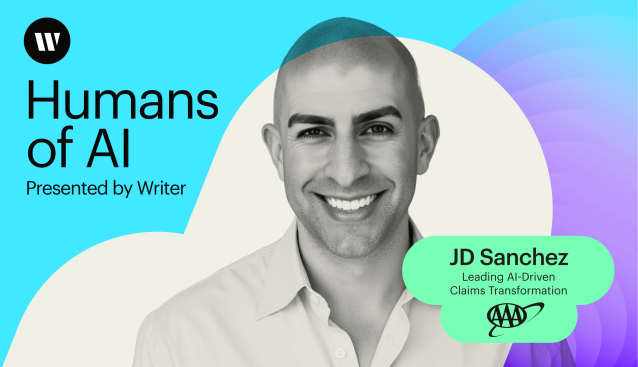Humans in the loop
– 9 min read
From P&G to WRITER: How Kushala Silva is helping CPG giants win the AI race

Think about your morning routine for a moment — that toothpaste you’ve used for years, the cereal that always makes it into your shopping cart. What if they evolved to match exactly what you need and want? Sounds like science fiction, right? Not quite. Thanks to the transformative power of AI, this world is rapidly becoming a reality, and the consumer packaged goods (CPG) industry is at the epicenter of the revolution.
Meet our latest guest on Humans of AI, Kushala Silva. He’s a seasoned CPG veteran with nearly two decades of experience, and he’s seen it all — from the early days of eCommerce to the current AI-fueled gold rush. As the CPG Lead at WRITER, Kushala has worked with some of the biggest names in the business, including Procter & Gamble (P&G), Coca-Cola, and Amazon Private Brands (APB).
In our latest episode of Humans of AI, Kushala shares his insider perspective on the future of CPG and AI’s pivotal role shaping it. From personalization at scale to navigating the complex commerce ecosystem, Kushala reveals the strategies, insights, and lessons learned from his journey to the forefront of AI adoption in CPG.
- Kushala Silva discusses the transformative impact of AI in the consumer packaged goods industry, emphasizing personalization, omni-channel optimization, and efficiency.
- AI is enabling CPG companies to tailor products to individual consumer preferences and analyze vast amounts of customer feedback quickly and cost-effectively.
- CPG executives are increasingly receptive to AI solutions that can be replicated across their organizations and deliver measurable ROI.
- Kushala sees the future of CPG workflows as self-evolving and autonomous, where processes can learn and improve without constant human intervention.
- The key to AI adoption in CPG is collaboration between tech and business teams. It also needs a strategic approach that avoids isolated, DIY efforts and focuses on scalable, revenue-driven solutions.
Consumer connection as a calling
Nearly 20 years in the CPG world have taken Kushala from the research labs of Stockholm to the boardrooms of global giants like P&G and Coca-Cola to his current role at WRITER. While his resume reads like a who’s who of household brands — including a stint at APB — his passion for transformation truly defines his career journey.
Kushala is drawn to CPG companies because they cover the entire spectrum of business — from research and development to manufacturing, marketing, and sales.
“Consider a brand like Tide,” he says. “You do the research to make Tide product. You create the product in a manufacturing supply chain environment, you market it, you sell it. So in the CPG organization, you literally have all the functions.”
The scale of these operations clearly fascinates him, but Kushala’s self-proclaimed “spark” comes from the consumer-focused aspect of the industry. He speaks about how consumer preferences continually evolve and how markets are far from homogeneous. There’s never a dull moment when you’re navigating these complexities to meet diverse consumer needs.
“I think about the consumers every day and how I can help them,” Kushala says. “It has become a part of me, I would assume.”
How your soda mix becomes market research
Ever tried a Coca-Cola Freestyle Machine at the movies? That sleek touchscreen was a technological leap from when kids would quickly swap their cups between different flavors at the soda fountain (because who couldn’t resist pairing Fanta and Sprite?). But every time you try a wacky flavor combo, you’re also fueling Coca-Cola’s innovation pipeline. For Kushala, this was his first full AI project, demonstrating the power of data-driven customer engagement and personalization.
Kushala sees this as just one of three key areas where AI is transforming the CPG industry:
- Personalization at scale: AI helps tailor products to individual consumer preferences, making each shopping experience more personalized.
- Omni-channel ecosystems: With the rise of eCommerce and multiple shopping channels, AI helps CPG companies navigate and excel in these diverse ecosystems — ensuring the optimization of the digital shelf for each platform.
- Efficiency and optimization: CPG companies often operate on thin margins. AI can drive efficiencies across compliance, sales, and supply chain — improving the entire consumer journey.
The waiting game no brand can afford
Kushala says in the CPG world, no one can afford to play the “wait and see” game when bringing AI into their business operations and strategies. He says that everyone in his network is taking AI seriously because customers will notice CPG companies that aren’t.
In CPG, industry leaders are finding AI solutions that offer far more transformative value than just chatting with a digital co-pilot. Think big picture, like producing thousands of product detail pages (PDPs) and translating them for different markets — or synthesizing customer sentiment.
Kushala shares the story of a food and beverage client that initially approached AI with skepticism. The company wanted to analyze consumer sentiment at scale — a complex task requiring the synthesis of vast amounts of feedback to identify statistically significant trends.
“We delivered a capability so that they could do this consumer synthesis and consumer research at a fraction of a cost and taking days as opposed to weeks,” Kushala explains. “… [N]ow generative AI is delivering ways that you really fundamentally transform the organizations. So I was surprised because the insight that we were able to come out with was actually better than a traditional agency that they used before to get this information.”
Rewiring century-old CPG giants
Kushala says AI is like the new electricity — the real question is how you use it. Making a claim this revolutionary is bold, especially in an industry with 100- and 200-year-old companies. Rewiring these giants with cutting-edge tech might seem daunting, but it’s more approachable than you’d think — thanks to existential pressure from nimble competitors.
“CPG companies also facing challenges from niche brands. So if you are a major beauty brand — now Rhinna’s brand is up and coming. So you have celebrity brands coming,” Kushala explains. “What you are seeing is CPG companies are also trying to safeguard their turf. The way that they safeguard their turf is really adapting these new capabilities.”
The stakes are clear to industry veterans: adapt or risk obsolescence. However, Kushala acknowledges that implementation varies across organizations and departments. Security and data protection remain looming concerns for these corporations, which is why Kushala’s approach emphasizes solutions that don’t require training on sensitive corporate data — like WRITER.
But he notes that once companies find the right AI vendor with the proper functions and processes in place, they’re excited to move forward very quickly. The days of proof of concepts are largely behind us. Today, CPG companies seek solutions that can be replicated across the organization and drive meaningful ROI.
“Most of the customers that […] I speak day in, day out, they have done many proof of concepts,” Kushala explains. “Now what they’re looking for is replicability across the organization. How can I just have this capability and drive ROI? Any conversation that we have with an executive really starts with ROI and they [are] also looking for, is it corporate ready?”
The century-old giants, it seems, aren’t just willing to change — they’re racing to lead the charge. Kushala’s recent conversation with C-level executives at a major CPG company highlights this shift. They were impressed by WRITER’s vision of creating interoperability among AI agents and an orchestration layer that allows different organizations to tap into the power of generative AI.
The executives had come expecting a standard generative AI pitch, but they received an industry-defining vision. “The CIO pretty much said that she has not heard that from any other company,” Kushala shares. “I mean, that was such a great sentiment.”
Hard numbers for the hardest questions
When it comes to winning over CPG executives on AI adoption, Kushala has made impressive progress championing WRITER. However, one stubborn misconception continues to surface in his conversations with industry leaders.
“Where’s the ROI?”
This question echoes through boardrooms whenever AI enters the discussion. Kushala understands this skepticism. A united tech and business team is required to drive real results. And according to our enterprise AI adoption report, the companies achieving the greatest ROI have an AI strategy in place. Both of these require proper change management and support from the top.
Plus, the DIY approach many companies take — building capabilities in isolated pockets across the organization — often makes it nearly impossible to quantify returns on investment.
“But with WRITER, we lean in with the revenue,” he says. “We talk about some of the executions that we have done with our customers, and I think that is a good way of really showcasing this. We know that some of the executions that we have, we can quantify and say, ‘This is the revenue that generative AI can bring it.’”
Central to this strategy are value calculators that break down assumptions and projections into digestible components. These tools don’t avoid hard questions — they encourage them. By inviting leaders to scrutinize the building blocks and assumptions behind the calculations, the conversation shifts from skepticism to collaboration.
From static systems to self-optimizing solutions
The next frontier, as Kushala sees it, is the rise of self-evolving workflows. Gone are the days of static processes that require constant manual intervention and optimization. Kushala envisions something far more powerful — systems that learn and improve autonomously.
“Imagine you create a process today. And the process collects the information, provides the business outcomes, and another agent or another process understands the business outcomes and the inputs that we put, and it’ll self-correct and self-optimize,” Kushala explains. “…[C]orporations can transform their workflows, and they will truly become autonomous workflows.”
Kushala constantly finds inspiration in the innovative ideas his customers bring to the table. He says they’re thinking of workflows he hasn’t even considered. It’s this excitement and the market’s evolution that keeps him energized.
Innovation thrives at the intersection of partnership and vision. Don’t wait for the perfect moment — the organizations that flourish are those bold enough to take decisive first steps, embracing iteration as their competitive advantage. The journey of continuous improvement, rather than the mirage of instant perfection, ultimately defines tomorrow’s industry leaders.
Want to hear more stories from the humans working at the crossroads of business and generative AI? Subscribe to Humans of AI wherever you listen to podcasts.


